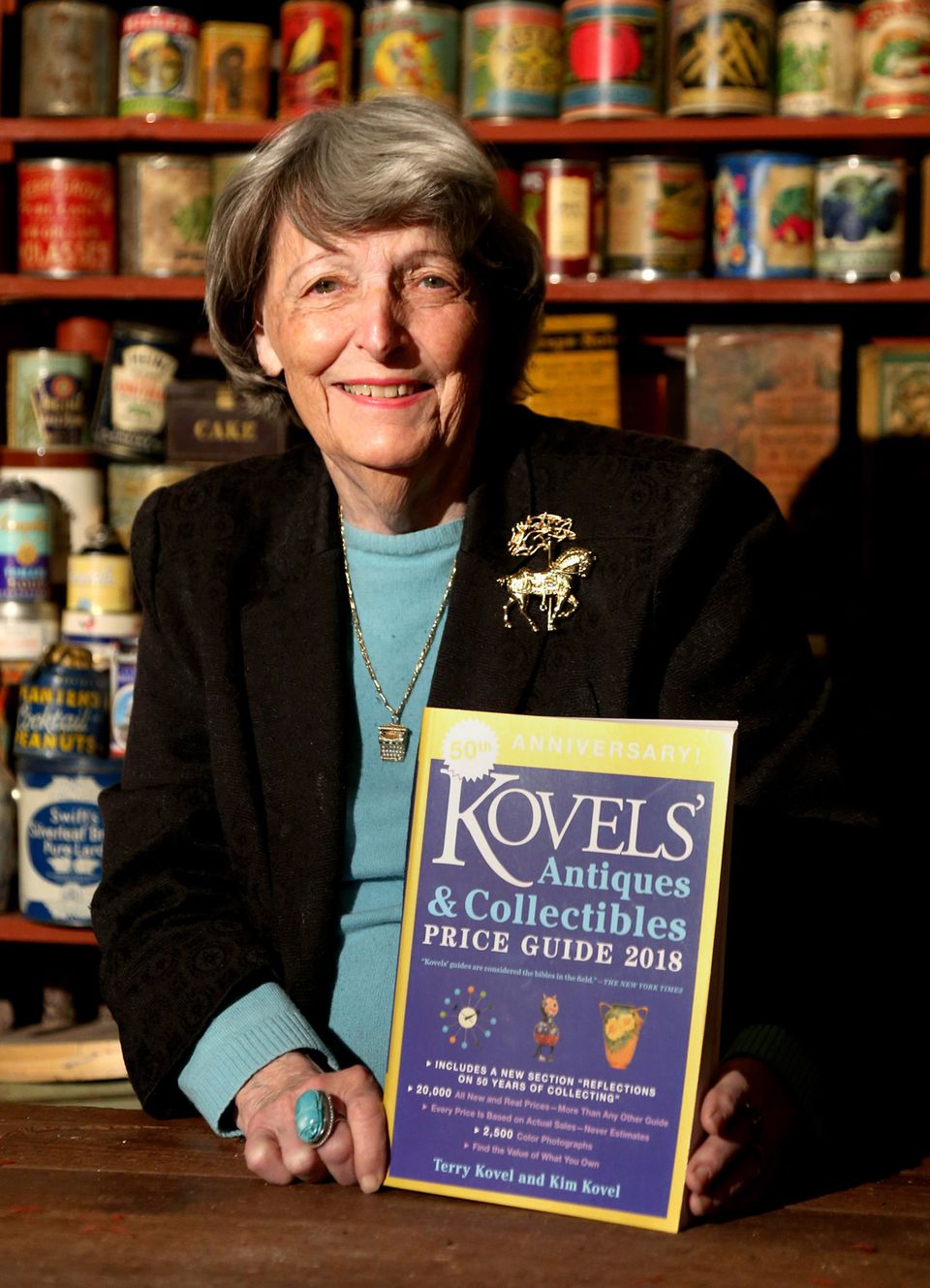
The article appears at Cleveland.com and is re-printed below. Our thanks to Roxanne Washington and The Plain Dealer.
Shaker Heights antiques expert Terry Kovel celebrating her 50th annual ‘Price Guide’ book
By Roxanne Washington, The Plain Dealer
SHAKER HEIGHTS, Ohio – Terry Kovel of Shaker Heights got a big kick out of something her gas meter reader told her the other day.
He shared with Kovel that he is a “sneakerhead” – a collector of sneakers, particularly pricey brands and styles associated with sports and sports figures, to trade, sell or just hang on to for fun.
Why would the meter reader assume that she cared about his hobby?
Because Kovel, who is celebrating her 90th birthday this year, is the doyenne of antiques and collectibles – 107 books, syndicated column in 100 newspapers across the country, multiples television appearances – and has been for many years. However, until that chat, the word “sneakerhead” wasn’t in her extensive collectibles vocabulary.
“Apparently, it’s a big business,” Kovel says with amusement.
Kovel recently reached a milestone in her life and profession. She and her daughter, Kim, released the 50th anniversary “Kovels’ Antiques & Collectibles Price Guide 2018” ($29.99, Black Dog & Leventhal). The first “Complete Antiques Price List” was published in 1968.
The new edition features 20,000 prices of items ranging from figurines to furniture, and 2,500 pictures arranged in more than 750 categories. Like previous editions, the 554-page, large paperback book is organized by both category and maker. along with most sought-after items, such as Depression Glass, Dolls, Jewelry, Furniture, Art Pottery, and Sports Memorabilia. Highly sought-after makers include Rookwood, Tiffany, Fiesta, Wedgwood and Hummel.
There’s a bonus section: “Terry Kovel’s “Reflections on 50 years of Collecting.” Personal anecdotes and a timeline recall the most important events, auctions, social changes and fads that have impacted the antiques and collectibles market.
For instance, in 1922, the magazine “Antiques” was launched, catering to art collectors and museum curators. Americans hadn’t caught the antiques bug back then. It was all just stuff you inherited, not something you purchased, Kovels says during an interview at her home, which is so stuffed with art, furniture and the like, there seems little room for even one more item.
Looking back, bottles, stamps and coins were the first organized collecting interests in the United States, Kovel says. After World War II, some of the returned servicemen who had seen antiques in Europe and Japan became interested in furniture, glass and ceramics in the United States. A group of California men started digging for bottles, and, in 1959, they started a club that eventually became the Federation of Historical Bottle Collectors. Bottle collecting became such a popular hobby that Terry and Ralph wrote a separate price book, “Kovels’ Bottle Price List,” every year from 1971 to 2006.
In the 1970s, the mainstream public caught the flea market bug. And so the timeless goes.
Kovel recalls how she and Ralph became the go-to couple for antiques and collectibles, for both experts and novices.
“I was about eight and I was in Niagara Falls with my mother, and I bought a moustache cap,” says Kovel, who works out of her home with a staff of 10. “She gave me a dollar to spend and I used a quarter for the unusual cup.”
She still has it.
When she and Ralph married in 1950, they filled their first apartment with Williamsburg reproductions. Williamsburg, real or knockoff, was a popular in those days, says Kovel. As for the rest of the couple’s decor, Kovel’s mother offered a suggestion that would hugely impact the couple’s lives.
“She said we should go to house sales and get some interesting lamps and ash trays,” Kovel remembers. “So we did, but we really didn’t understand anything.”
As the couple sought to learn more about the items they were finding, they asked about the identifying marks on dishes and vases, but no one knew much. Ralph started listing marks by shape in a notebook with short descriptions. He didn’t tell Terry that he sent a letter to a publisher with an idea for a book. Six months later, Ralph got a letter from the publishers saying they wanted to publish it, and they offered an advance equal to six weeks of his salary. The couple spent the next year writing the first general marks book for collectors. “Dictionary of Marks – Pottery & Porcelain,” released in 1953.
“So we got the book out, and suddenly we were experts.” Kovel says, laughing. “I read all of the reviews. We were ‘brilliant.'” Later Ralph said, “Since we’re so smart, why not write a newspaper column?'”
In the beginning, an item had to be at least 50 years old to be included in the price books.
“Nowadays you can go to an auction and buy something that was made last week,” Kovel jokes.
The company website, Kovels.com, offers more than a million free prices, and includes a weekly email, “Kovels Komments.” That offers readers a view of the market through the latest news, auction reports, readers’ questions and more. There’s also a “Kovels On Antiques & Collectibles” subscription newsletter.
In a press release Q & A, Kovel comments on what she would recommend a collector buy today.
“Original fifties furniture by name designers, but not the many modern copies,” she says. “Artist-made, modern-looking jewelry. And, if you’re on a very tight budget, early colored Pyrex with added designs. Some things are inexpensive because they have been out of style. Today, American art pottery and ceramics from the 19th century are starting to go up in price at auctions but are still ignored at estate sales. Large, modern colored glass vases and garden furniture are also hot.”






Leave a Reply
You must be logged in to post a comment.